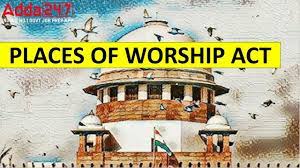Introduction
The Places of Worship Act of 1991, also known as the Ayodhya Act, is a landmark piece of legislation in India’s history that sought to address the sensitive issue of religious sites and places of worship. This act was introduced to maintain communal harmony and ensure the preservation of historical religious sites and structures. The debates leading to the passing of this act in the Indian Parliament were both intense and momentous, reflecting the nation’s commitment to religious tolerance and cultural heritage preservation.
Historical Context
The need for the Places of Worship Act was primarily driven by the Ayodhya dispute, which had been a contentious issue for decades. The dispute revolved around the Babri Masjid in Ayodhya, a site claimed by both Hindus and Muslims as a place of religious significance. Tensions between the two communities often flared up, leading to communal violence and strife.
Debates in Parliament
The discussions surrounding the Places of Worship Act were emotionally charged, reflecting the deeply rooted religious sentiments of the Indian populace. These debates were held with the aim of finding a peaceful and just resolution to the longstanding conflict over religious sites and structures.
- Religious Freedom and Cultural Heritage: Many members of Parliament stressed the importance of protecting the religious freedom of all citizens, while also preserving the cultural and historical heritage of the nation. It was argued that religious places should not be subject to change without careful consideration.
- The Secular Nature of India: The debates highlighted India’s commitment to secularism, enshrined in the Indian Constitution. Members of Parliament emphasized that India is a diverse nation where people of all religions should coexist peacefully.
- Avoiding Future Conflicts: A recurring theme in the debates was the necessity to prevent future disputes over places of worship. The act sought to put a freeze on the status quo of religious sites as of 1947, effectively maintaining the existing religious structures.
- Judicial Intervention: The debates recognized the role of the judiciary in resolving religious disputes, and the act provided for the establishment of a special court for adjudicating disputes that arose due to the legislation.
- National Unity: The discussions reiterated the significance of national unity and the importance of fostering harmony among all religious communities. The act was seen as a step towards reconciliation and peaceful coexistence.
Passing of the Act
After intense deliberations and debates, the Places of Worship Act was passed in 1991. The act aimed to preserve the religious character of places of worship as they stood in 1947. It was a significant step towards resolving the contentious issue of religious sites in India. The act sent a strong message of the government’s commitment to maintaining peace and communal harmony while safeguarding the cultural and historical heritage of the nation.
Impact and Aftermath
The Places of Worship Act has played a crucial role in diffusing tensions and preventing further conflicts over religious sites in India. It has provided a legal framework for addressing disputes in a peaceful and just manner, emphasizing the importance of secularism, religious tolerance, and cultural preservation.
Conclusion
The parliamentary debates leading to the enactment of the Places of Worship Act were a testament to India’s commitment to upholding its secular ideals and promoting religious tolerance. The act has been instrumental in maintaining peace and stability, preventing religious conflicts, and preserving the nation’s rich cultural heritage. It serves as a reminder that a diverse nation like India can find peaceful solutions to complex religious issues through dialogue and legislation.

